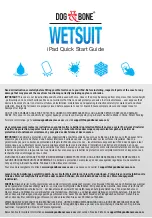
Page 14 of 28
⚠
WARNING
Make sure the rubber pads are placed between the underside of the body bracket and surface of trailer
during assembly.
12. Use bolts (23), lock nuts (32), and washers (30) to fasten snap latches (18) to the top inside of
the upper shell (14). The snap latches will be used to keep the top shell shut during use.
13. Use bolts (28), lock nuts (32), and washers (30) to fasten the hinge brackets (16) to the side
interior of the upper shell.
14. Use lock nuts (33) and washers (31) to fasten the ends of the gas springs (17) to the bottom front
and back sides of the bottom shell and the front and back sides of the upper shell.
15. Connect the cooler rack to the draw bar with a U-bolt (37) with plate (41) with lock nuts (34).
16. Connect the rear bumper to the trailer body with a bolt (45) and lock nuts (33).
17. Once assembly is complete, test the trailer. Do this by rolling several times to make sure the tires
roll smoothly and are in proper alignment. Open and close the upper shell to make sure it is
properly aligned and closes and locks securely. Make sure all hardware is fastened tightly. Once
these safety checks have been done, the trailer is ready for use.
Before Each Use
⚠
WARNING
Before each use, always examine the trailer for proper tire condition and air pressure, damaged Tail
Lights, damaged Side Running Lights, loose bolts and nuts, structural cracks, bends and any other
condition that may affect its safe operation. Do not use the Trailer even if minor damage appears.
Before each use, always attach the Safety Chains of the trailer to the towing vehicle. Make sure the
Safety Chains are attached to the towing vehicle with the equal length at each side. Do not allow
the Safety Chains to drag on the ground.
Make sure hitch, coupler, draw bar, and other equipment that connect the trailer and the tow vehicle
are properly secured and adjusted.
Make sure the hitch coupler and the
vehicle’s Ball Hitch (not included) are of equal mating size and
are rated equal to or greater than the weight of the trailer and its payload.
The coupler must be properly secured to the hitch ball. After assembly and attachment, pull up and
down on the hitch coupler to make sure the hitch ball is snug in the hitch coupler. If the coupler is
not secured properly, it could come loose while the trailer is in motion, causing property damage,
serious personal injury or even death.
Make sure wiring is properly connected
— not touching the road, but loose enough to make turns
without disconnecting or damaging the wires.
Check that all items are securely fastened on and in the trailer.
Be sure the trailer jack, tongue support, and any attached stabilizers are raised and locked in place.
Check the load distribution to make sure the tow vehicle and trailer are properly balanced front to
back and side to side.
Check side- and rear-view mirrors to make sure you have good visibility.
Check routes and restrictions on bridges and tunnels.
Make sure you have wheel chocks and jack stands.
Содержание 57762
Страница 8: ...Page 8 of 28 ...
Страница 24: ...Page 24 of 28 Parts Diagram ...













































